 The largest single employer in the Colac region, the Australian Lamb Company (ALC), is part of a group of project partners who will benefit from $6 million in Coalition Government funding to help convert animal wastes into valuable products such as fertilizers and energy, as part of a project led by Meat & Livestock Australia (MLA).
The largest single employer in the Colac region, the Australian Lamb Company (ALC), is part of a group of project partners who will benefit from $6 million in Coalition Government funding to help convert animal wastes into valuable products such as fertilizers and energy, as part of a project led by Meat & Livestock Australia (MLA).
Deputy Prime Minister and Minister for Agriculture and Water Resources, Barnaby Joyce, and Member for Corangamite, Sarah Henderson, said the innovative project was funded under the third round of the Australian Government’s Rural Research and Development (R&D) for Profit programme.
“MLA will develop technologies and business models with the potential to help processors, like ALC here in Colac, to convert wastes from the red meat, dairy and pork industries into fertilizers, chemicals, energy and other valuable products,” Minister Joyce said.
“ALC, which employs more than 750 employees, will be involved in the project by testing whether waste from their processing plant can be converted into energy, fertiliser or nutritionally enhanced feeds.
Ms Henderson said the project would see MLA work with 18 project partners, together contributing almost $8 million in cash and in-kind support for the project, with ALC committing $80,000 in cash support
“The Warrnambool and South West region of Victoria generates almost 20 per cent ($2.4 billion) of the state’s $13.1 billion agricultural production, so that’s a lot of waste,” Ms Henderson said.
“It is estimated that the management of wastes costs Australia’s agriculture industries as much as $200 million each year and this work has the potential to deliver exciting opportunities for many producers here in the Corangamite region.”
General Manager for ALC, Darren Verrall said ALC is pleased to be participating in the joint project with the Federal Government and the MLA.
“We are very keen to investigate how we can work with Barwon Water to better manage our waste products. Using innovative methods we will explore ways to turn costly waste into useful by-products like gas to produce energy to reduce our electricity costs,” Mr Verrall said.
